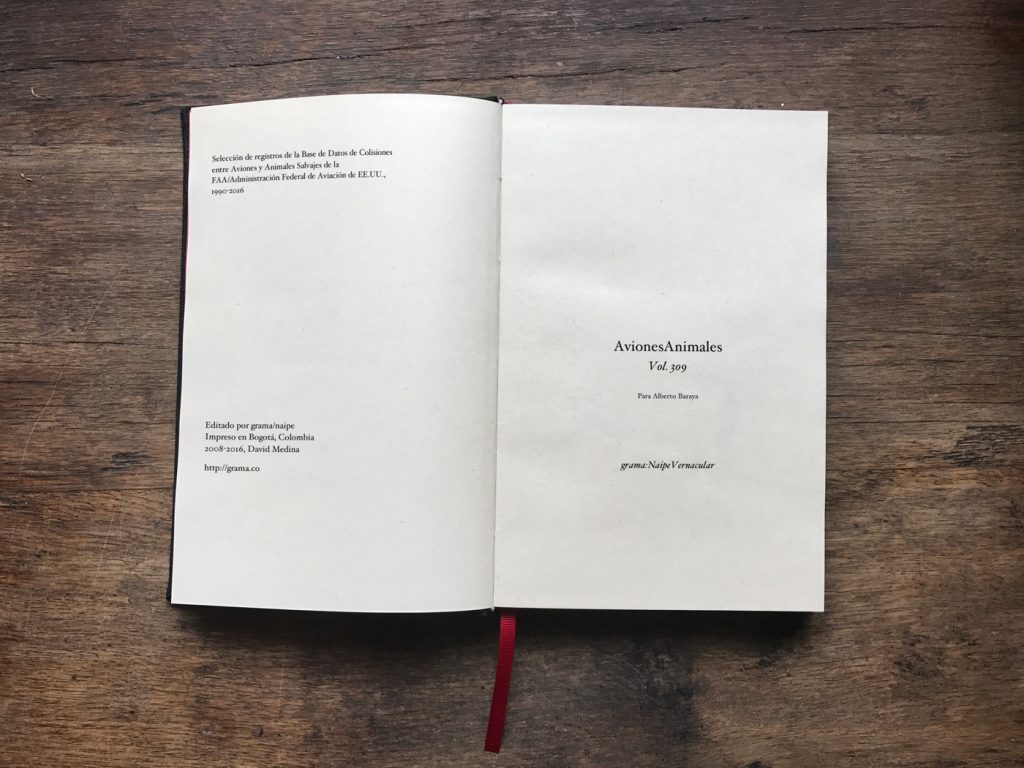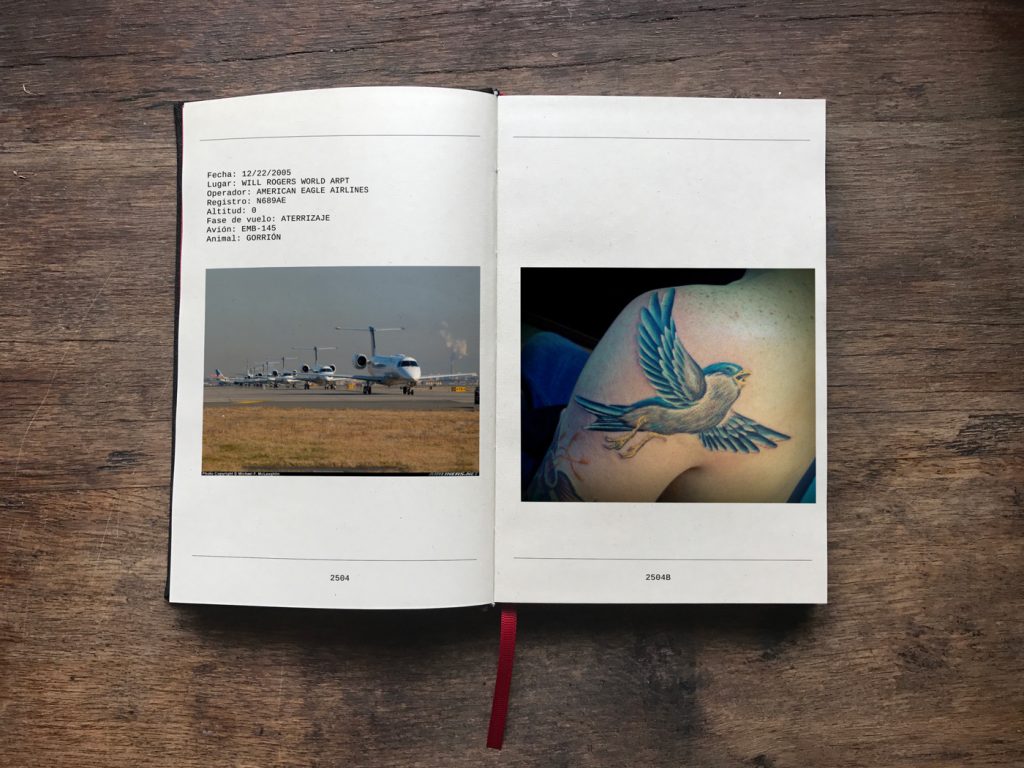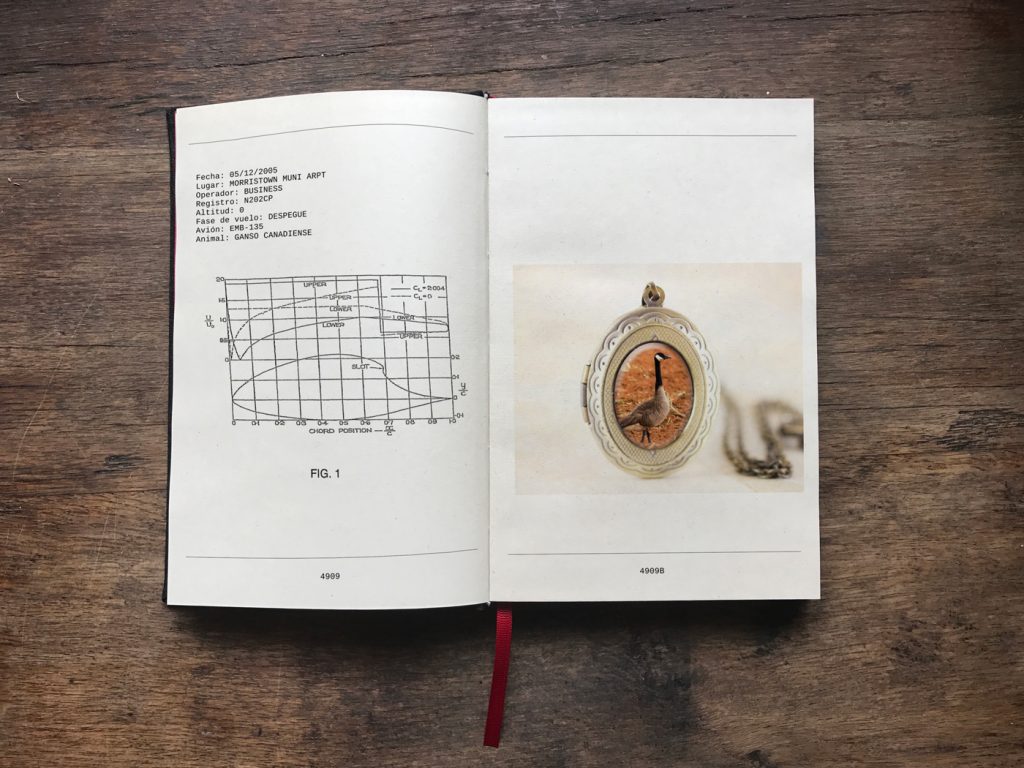Algoritmo, bot de Twitter y producción autónoma de fotolibros a partir de la base de datos “Colisiones de vida silvestre a aeronaves civiles en los Estados Unidos 1990-2012” de la Administración Federal de Aviación (FAA).
Este libro se crea por un algoritmo que analiza el sonido de un río cerca de mi casa en Bogotá, Colombia. El programa de software toma los valores de amplitud del sonido del río (que he grabado en varias ocasiones y lugares del canal) y mapea estos valores a los miles de registros en la base de datos, comportándose básicamente como la semilla para la selección. El río, mediante reglas simples y arbitrarias, selecciona los registros y crea un PDF listo para imprimir en pocos minutos. El libro creado siempre es único. Un bot de Twitter continúa la lógica del libro tuiteando cuatro veces al día un nuevo conjunto de colisiones de animales y aviones en https://twitter.com/avionesanimales [Ver más Twitter bots]
Cada doble-página del libro es el registro de una colisión entre aviones y animales salvajes desde 1990 en aeropuertos de EEUU. La página izquierda de cada pliego tiene una fotografía de la aeronave y la derecha muestra una imagen del animal involucrado en la colisión. Un texto en la esquina superior izquierda muestra la fecha, aeropuerto, modelo de avión, especie animal y otras variables. Las imágenes se obtienen automáticamente a través de Google Images aportando otra capa de indeterminación a todo el sistema. En muchas ocasiones las imágenes que describen a un avión o un animal pueden ser el interior de un hotel, un tatuaje o algún documento críptico. Cada uno describe una colisión entre naturaleza y cultura en algo que podríamos llamar ‘narrativa de base de datos’.
Cada libro es único y la gran cantidad de combinaciones es tan grande que podríamos cubrir la superficie de la Tierra sin repetir un solo libro. Cada volumen está impreso en papel de caña de azúcar con encuadernaciones hechas a mano en ediciones únicas. 350 páginas, paginación aleatoria.
Una versión monocromática fue presentada en artBo, octubre de 2016 – Sección de libros de artista con la ayuda de Galería Sextante y Arte Dos Gráfico. Colección de Timothy Prus.
Authorial algorithm, Twitter bot and autonomous photobook production from the database “Wildlife strikes to civil aircraft in the United States 1990-2012” from the Federal Aviation Administration.
This book is created in its entirety by an algorithm that analyses the sound of a river close to my home in Bogotá, Colombia. The script takes the values of sound amplitudes and maps these values to the thousands of records in the database, basically behaving as the seed for selection or a sonogram in book form. The river, through arbitrary and simple rules, selects the records and creates a ready-to-print PDF that is always unique in less than a few minutes. A twitter bot continues the logic of the book in this digital platform, tweeting four times a day a new set of animal/aircraft strikes at https://twitter.com/avionesanimales [See more Twitter bots]
Every spread of the book is a record of a collision between aircrafts and wild animals since 1990 in airports in the US. The left page of every spread has a photograph of the aircraft and the right shows a picture of the animal involved in the collision. A text in the upper left hand corner shows the date, airport, aircraft model, animal specie, altitude and other variables. The images are obtained automatically via Google Images bringing another layer of indeterminacy to the whole system. In many occasions the images that describe an airplane or animal can be the interior of a hotel, a tattoo or some cryptic document. Every time is a clash between nature and culture in some sort of of database narration.
Every book is unique and the sheer number of combinations is so big that we could cover the surface of the Earth without repeating a single book. Every volume is printed in sugar cane paper with hand made bindings in unique editions. 350 pages, random pagination.
A B&W version was presented at artBo, October 2016 – Artist’s books section with the help of Galería Sextante and Arte Dos Gráfico. Timothy Prus Collection.






